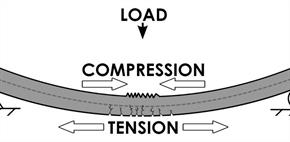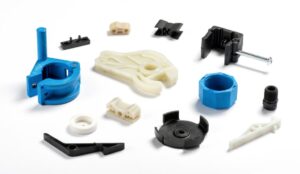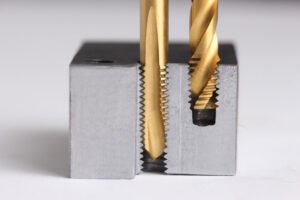What is Quality Control for CNC Machining?
Quality control for CNC machining is a process used to ensure that parts and components produced using CNC machines meet specified quality standards and requirements. Quality control for CNC machining typically involves the use of a combination of inspection and testing methods to evaluate the dimensions, tolerances, surface finish, and other characteristics of the parts being produced. This can include methods such as visual inspection, dimensional measurement, and functional testing.
The specific quality control methods used for CNC machining will depend on the requirements of the project, as well as the type of materials and processes being used. Quality control for CNC machining can be performed at various stages of the manufacturing process, including during setup and programming, during the machining process itself, and after the machining process is complete.
Quality control for CNC machining is an important aspect of the manufacturing process, as it helps to ensure that the parts being produced meet the required quality standards. This can help to reduce waste and rework, improve product reliability and performance, and increase customer satisfaction.
Why we need cnc machining quality control?
There are several reasons why quality control is important for CNC machining. Some of the main reasons include the following:
- Ensuring product quality: Quality control is critical for ensuring that the parts and components produced using CNC machining meet the required quality standards. This can help to ensure that the parts are fit for their intended use, and can help to reduce the risk of defects or failures.
- Reducing waste and rework:By identifying and addressing quality issues during the manufacturing process, quality control can help to reduce the amount of waste and rework that is generated. This can help to improve the efficiency and productivity of the CNC machining process, and can also help to reduce costs.
- Improving customer satisfaction:Quality control is essential for maintaining customer satisfaction, as it helps to ensure that the parts and components being produced meet the required quality standards and specifications. This can help to build customer trust and confidence, and can also help to improve the reputation of the CNC machining company.
- Improving product reliability and performance: By identifying and addressing quality issues, quality control can help to improve the reliability and performance of the parts being produced. This can help to reduce the risk of failures or defects, and can help to ensure that the parts are fit for their intended use.
- Maintaining quality consistency: Quality control can help to ensure that the quality of the parts being produced is consistent from one batch to the next. This can help to reduce the risk of quality variations or defects, and can also help to improve the overall quality of the parts being produced.
- Identifying and addressing quality issues: Quality control can help to identify quality issues that may be present in the CNC machining process, and can provide information and guidance on how to address these issues. This can help to improve the overall quality of the parts being produced, and can also help to prevent the same issues from occurring in the future.
- Supporting continuous improvement:Quality control can provide valuable data and insights that can be used to support continuous improvement efforts in the CNC machining process. This can help to identify areas for improvement, and can also help to implement and evaluate the effectiveness of improvement efforts.
- Providing a competitive advantage: By consistently producing high-quality parts and components, quality control can help to give a CNC machining company a competitive advantage over its rivals. This can help to differentiate the company from its competitors, and can also help to attract and retain customers.
- Enhancing product safety: Quality control can help to ensure that the parts being produced using CNC machining are safe for their intended use. This can help to reduce the risk of injuries or accidents, and can also help to protect the reputation of the CNC machining company.
- Supporting quality certification:In some cases, CNC machining companies may be required to obtain quality certification, such as ISO 9001 certification. Quality control is an essential part of the process of obtaining and maintaining quality certification, as it helps to ensure that the company is meeting the required quality standards.
- Supporting customer audits: Many CNC machining companies may be subject to customer audits, which are used to evaluate the quality of the parts being produced. Quality control can help to support these audits, and can provide the necessary documentation and evidence to demonstrate that the company is meeting the required quality standards.
Overall, quality control is an important aspect of CNC machining, as it helps to ensure that the parts being produced meet the required quality standards and specifications. This can help to improve the efficiency, productivity, and reputation of the CNC machining company, and can also help to ensure customer satisfaction.
What do we need to do better quality control for cnc machining?
- Develop and implement quality standards
- Use inspection equipment
- Conduct visual inspections
- Test functional properties
- Implement quality control measures
- Conduct audits and evaluations
- Use quality control software
- Use statistical process control (SPC)
- Use defect tracking and reporting
- Use corrective action procedures
- Use continuous improvement methods
- Use customer feedback
- Use supplier quality control
- Use quality management systems
- Use first article inspection
- Use process control
- Use failure mode and effects analysis (FMEA)
- Use root cause analysis
- Use performance metrics
- Use training and certification
- Use quality control documentation
- Use preventative maintenance
- Use quality control feedback loops
- Use quality control partnerships
- Use quality control metrics
- Use quality control audits
- Use quality control reporting
- Use quality control feedback
- Use quality control improvement plans
What quality control steps do we need to do before manufacturing?
CNC machining quality control is an important aspect of the manufacturing process. There are several steps that can be taken to ensure the quality of CNC machined parts before manufacturing begins. Some of these steps include:
- Establishing clear and detailed specifications for the parts: Before manufacturing begins, it’s important to establish clear and detailed specifications for the CNC machined parts. This might involve creating detailed drawings and models of the parts, as well as specifying the required dimensions, tolerances, and other key characteristics.
- Selecting the right materials and cutting tools: Choosing the right materials and cutting tools is crucial for ensuring the quality of CNC machined parts. This might involve considering factors like the strength, machinability, and cost of the materials, as well as the quality and performance of the cutting tools.
- Testing the CNC machining process: Before beginning production, it’s important to test the CNC machining process to ensure that it is capable of producing parts that meet the specified requirements and tolerances. This might involve running a series of test parts and inspecting them using precision measurement tools.
- Developing and implementing quality control procedures: Developing and implementing strict quality control procedures is crucial for ensuring the quality of CNC machined parts. This might involve implementing inspection and testing processes, as well as setting strict tolerances for each part.
- Calibrating CNC machines: Regularly calibrating CNC machines can help to ensure that they are operating at peak performance and accuracy. This might involve conducting regular maintenance and servicing, as well as using precision measuring tools to check the accuracy of the machines.
Overall, taking these steps before manufacturing begins can help to ensure that CNC machined parts are of the highest quality and meet the specified requirements and tolerances.
What quality control steps do we need to do during manufacturing?
- Conducting visual inspections: The next step is to conduct visual inspections of the machined parts by trained personnel. This can involve looking for defects such as cracks, burrs, or other surface irregularities, and comparing the parts to the established quality standards.
- Testing functional properties: The next step is to test the functional properties of the machined parts to ensure that they meet the specified performance requirements. This can include tests such as durability, strength, and corrosion resistance.
- Implementing quality control measures: The next step is to implement quality control measures to prevent defects and ensure that the machined parts meet the specified quality standards. This can include processes such as quality checks at various stages of the production process, regular maintenance of equipment, and training of personnel.
- Conducting audits and evaluations: The final step is to conduct audits and evaluations to assess the effectiveness of the quality control processes and identify areas for improvement.
What quality control steps do we need to do after manufacturing?
Here are some common quality control steps that may be performed after the CNC machining process is complete:
- Visual inspection: After the machining process is complete, the parts can be visually inspected to identify any obvious defects or issues, such as surface imperfections, burrs, or other anomalies. This can be done using a magnifying glass, microscope, or other visual inspection tools.
- Dimensional measurement: After the machining process is complete, the dimensions of the parts can be measured to ensure that they meet the required tolerances and specifications. This can be done using a variety of dimensional measurement tools, such as calipers, micrometers, or coordinate measuring machines.
- Functional testing: After the machining process is complete, the parts can be tested to ensure that they function as intended. This can involve testing the parts under real-world conditions, or using the specialized testing equipment to evaluate their performance.
- Review of quality records: After the machining process is complete, the quality records for the parts can be reviewed to ensure that all required quality control measures have been performed and that the parts meet the required quality standards.
- Correction of defects and issues: After the machining process is complete, any defects or issues identified during the quality control process can be addressed and corrected. This can involve reworking the parts, using corrective measures, or scrapping the parts if they are not able to be repaired.
Overall, the specific quality control steps that are performed after the CNC machining process is complete will depend on the requirements of the project and the type of parts being produced.
What is CNC machining Quality Inspection Equipment?
- Surface finish testers: Used to measure the roughness, waviness, or other characteristics of the surface finish of parts.
- Go/no-go gauges: Used to quickly and easily verify whether a part meets the required specifications and tolerances.
- Optical comparators: Used to compare a magnified image of the part to the design specifications and tolerances.
- Laser scanners: Used to scan the surface of a part and measure its dimensions and tolerances with high precision and accuracy.
- Force gauges: Used to measure force or pressure applied to a part during the machining process.
- Hardness testers: Used to measure the hardness of a material, such as a part after machining.
- Dimensional calipers: Used to measure the dimensions of parts in multiple directions at once.
- Surface profilometers: Used to measure the surface profile of a part, such as the roughness or waviness of the surface.
These quality Inspection equipment and tools can be used to ensure that parts are inspected accurately and effectively, and meet the required specifications and tolerances.





